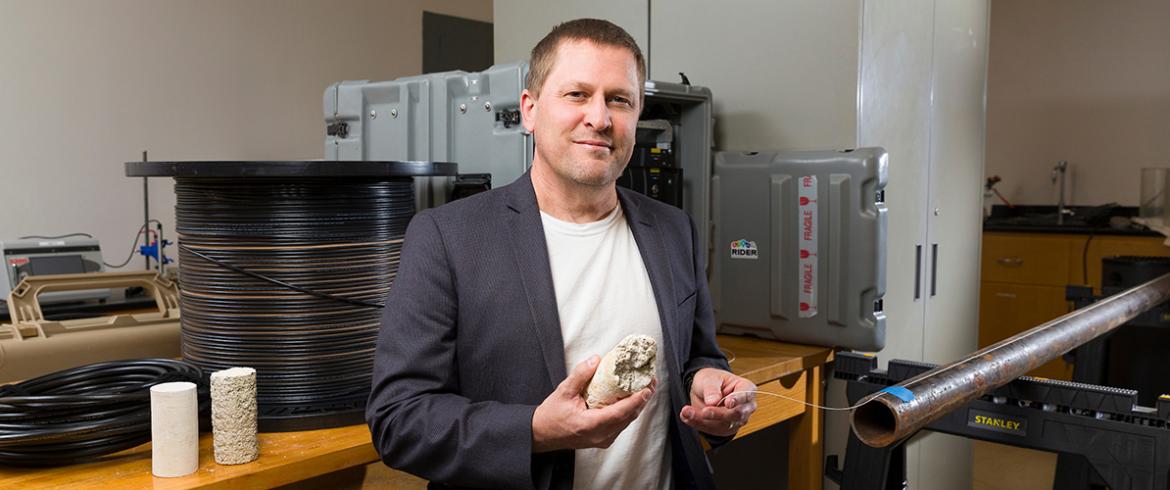
Scott Wasman, Ph.D., assistant professor of civil & environmental engineering, poses with fiber optic equipment and limestone core samples. (Scott Holstein/FAMU-FSU College of Engineering)
A new study by the FAMU-FSU College of Engineering’s Department of Civil & Environmental Engineering will probe the hidden stresses lurking beneath Florida’s building and bridge foundations.
Thousands of structures throughout Florida are supported on columns bored into soil and limestone formations. Research by Assistant Professor Scott Wasman will use fiber optic sensing to examine how the construction processes and geology affect the stresses that develop in those foundations, helping improve safety and reliability for future structures.
“Foundations carry the weight of an entire structure,” Wasman said. “The more we understand the interaction between the foundation and the geologic material, the better we will be at designing and maintaining structures.”
Many buildings and bridges rest on a pile foundation, which consists of many long cylinders bored into the ground to provide stable support for the structure above. Those piles are made of steel-reinforced concrete. When poured concrete cures and hardens, it undergoes a chemical reaction that generates heat. That heat radiates through nearby limestone and soil, which controls the heat dissipation through inherent thermal conduction properties. Limestone and soil may shrink or expand in response to heat. All of this can cause stress within the curing foundation.
Wasman and colleagues’ research will examine how the thermal conductivity and expansion/contraction properties of limestone and soil influence the amount and direction of axial stress in the piles. They will also investigate how to account for these factors in the design of bored pile foundations.
HOW IT WORKS
The research team will install fiber optic sensing in piles to collect data on thermal and mechanical strains over hundreds of points within bored pile foundations. They will deploy it at various locations along the Atlantic coast and South Florida. The piles will be tested for their load capacity and the data will show where significant stress occurs.
Wasman and his students will perform laboratory tests on the pile’s concrete and the limestone and soil samples to measure thermal-induced strains using high-resolution fiber optic sensing. This will create the first-of-its-kind data set specific to Florida design practice and inform future research into design methods that may account for near-future warming climate conditions.
WHY IT’S IMPORTANT
Thousands of structures in Florida rest on foundations built into limestone, which is especially common in South Florida. Understanding how practices and processes such as concrete curing affect foundation integrity is crucial to structural safety. Improved design methods, which account for all influencing factors, are better tools for engineers to use and reduce risk.
WHO IS FUNDING?
The Florida Department of Transportation is funding the study with about $429,000. Wasman is the co-principal investigator, working with researchers at the University of Florida. Funds from FSU allowed him to purchase the fiber optic system that will be used in the research.
RELATED ARTICLES
Researcher Works with FDOT to Evaluate Geosynthetic Reinforced Soil Structures
Engineering Professor Explains How His Work Helps Protect Communities from Hurricane Winds
Engineering professors win FSU GAP awards help faculty commercialize inventions
